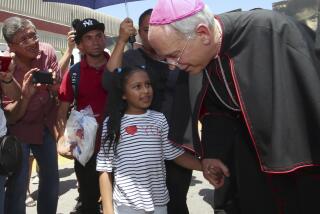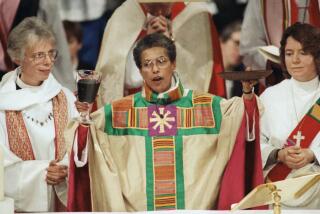Report to U.S. Bishops, Pope : Study Explores Decline in Catholic Religious Vocations
- Share via
Nearly three years ago, Pope John Paul II asked the nation’s Roman Catholic bishops to find out why unprecedented numbers of U.S. nuns, priests and brothers had left their orders and why religious vocations were attracting so few new members.
The chief reasons, according to a comprehensive study presented to the National Conference of Catholic Bishops in Washington last week, are a constellation of cultural factors, personal and life-style choices, changes in the American Catholic Church and the impact of the Second Vatican Council of 1962-65.
The slide in Catholic religious vocations has occurred over the last 20 years, following a peak in vocations in 1966-67. During the same time, the total U.S. Catholic population has jumped from 46.2 million to 52.6 million.
Big Decline in Nuns
Since 1966, according to the Official Catholic Directory, the number of U.S. nuns has declined from 181,421 to 113,658. The number of religious brothers has fallen from 12,255 to 7,429, and priests attached to religious orders from 22,774 to 22,028. The study did not deal with diocesan, or secular, priests, whose numbers decreased slightly from 36,419 in 1966 to 35,155 in 1986.
The most precipitous drop--in the number of nuns--was caused by new attitudes during the 1960s and 1970s toward women and their roles, both in society and in lay ministries of the church, the study commission concluded.
“There is considerable and spreading concern over the limited scope for participation by women in policy and decision-making roles in the church,” the commission, chaired by Archbishop John R. Quinn of San Francisco, said in an 18-page summary. “In view of this, some potential candidates find other modes of service and hesitate to enter religious life.”
The full 152-page report was based on extensive dialogue sessions between individual bishops and nuns, brothers and order priests. Data from the dialogues was assembled and studied by about 40 church experts, who in turn asked 17 bishops to elicit further reaction from priests, members of religious communities and lay people in their dioceses, Quinn said. His commission, which included Archbishop Thomas C. Kelly of Louisville and Bishop Raymond W. Lessard of Savannah, Ga., then compiled the final report.
Report Goes to Pope
Quinn presented the report to the Pope last month and briefed the nation’s bishops on it last week. Many bishops sent their own summaries to the Pope also, Quinn said.
“This more or less concludes our work,” Quinn said in a telephone interview this week, adding that the Pope said he will respond “after he has had time to consider . . . (the report) more carefully.”
The report does not make any specific recommendations to reverse what it calls “the serious problem of the numerical decline . . . in vocations.”
And, it points out that proportionally there are more members of religious orders and candidates for religious life in the United States than in nearly any other country. About 6% of the world’s 855 million Catholics live in the United States, yet about 27% of the world’s religious and 32% of the world’s novices (those in probationary training as brothers and nuns) are Americans.
A boom in women’s religious vocations occurred from 1945 to 1966 as women were pushed out of secular jobs and public service careers when men returned from the military after World War II.
“Many generous women of high ideals often chose to enter religious communities where they might fulfill their aspirations for broader . . . service to God and their fellow human beings,” the survey noted. “But by the 1960s an expanding economy again needed the services of women. Vocations declined as new options became available to them.”
Cultural factors cited by the report as contributing to the vocations’ decline include new attitudes toward freedom, authority and obedience; new views about intimacy, sexuality and women; rapid technological change, and the “difficulties of permanent commitment.”
Effects of Vatican Council
The Second Vatican Council, the report said, opened the ancient traditions of the Catholic Church to the influences of the modern world and offered new theological themes. One of these was “the universal call to holiness,” which the church had previously associated primarily with religious vocations and the priesthood.
“It became increasingly clear that one did not have to enter such a life in order to pursue . . . holiness,” the Quinn study concluded.
Vatican II also broadened the concept of private morality into an emphasis on the social dimensions of the Gospel and stressed the crucial role of lay ministry, the report said.
At the same time, the nature of U.S. Catholicism was changing dramatically, as Catholics moved out of a cultural ghetto into mainstream American society and were quickly assimilated into the general population. The Vietnam War, the Watergate scandal, the “psychosexual revolution” and the rise of the women’s movement undoubtedly also affected religious vocations, according to the survey.
In some instances, the report said, heads of religious orders based in Europe asked American branches of their communities to change “along the lines of the European experience,” setting up tensions.
In addition, women religious were becoming better educated, earning doctorates and joining university faculties. Combined with a rising consciousness of the civil rights movement, these “new professional” nuns no longer saw their vocations as just maintaining church institutions but as “service to the world” and, particularly, promoting justice and human rights.
Some nuns, brothers and order-priests and their communities have undergone an “identity crisis,” the survey found, adding that this has “sometimes led to a blurred corporate identity.”
Screening Process Cited
Members of religious communities “who had not deeply interiorized their religious life tended to drift into mediocrity or to leave,” the study said, noting that many emotionally or psychologically immature persons--finding it difficult to cope without a highly ordered structure--withdrew when religious rules were relaxed. Meanwhile, better selection methods helped “screen out applicants who are too passive.”
As fewer and fewer nuns teach in parochial schools, the religious life style is “less and less present to that age group which is making its life decisions,” the study said in further explaining the lack of vocation candidates.
Other reasons for decline listed in the report: Resistance to celibacy and permanent vows; confusion over roles of leaders and members, and tensions with the Holy See.
The Vatican is pressuring religious orders to limit dissent from church authority and teaching in their publications. And it ordered retractions from 24 U.S. nuns who signed a 1984 newspaper advertisement saying that “committed Catholics” hold diverse views about abortion. Two of the 24 sisters still face threatened expulsion from their orders over the issue.
More to Read
Sign up for Essential California
The most important California stories and recommendations in your inbox every morning.
You may occasionally receive promotional content from the Los Angeles Times.










